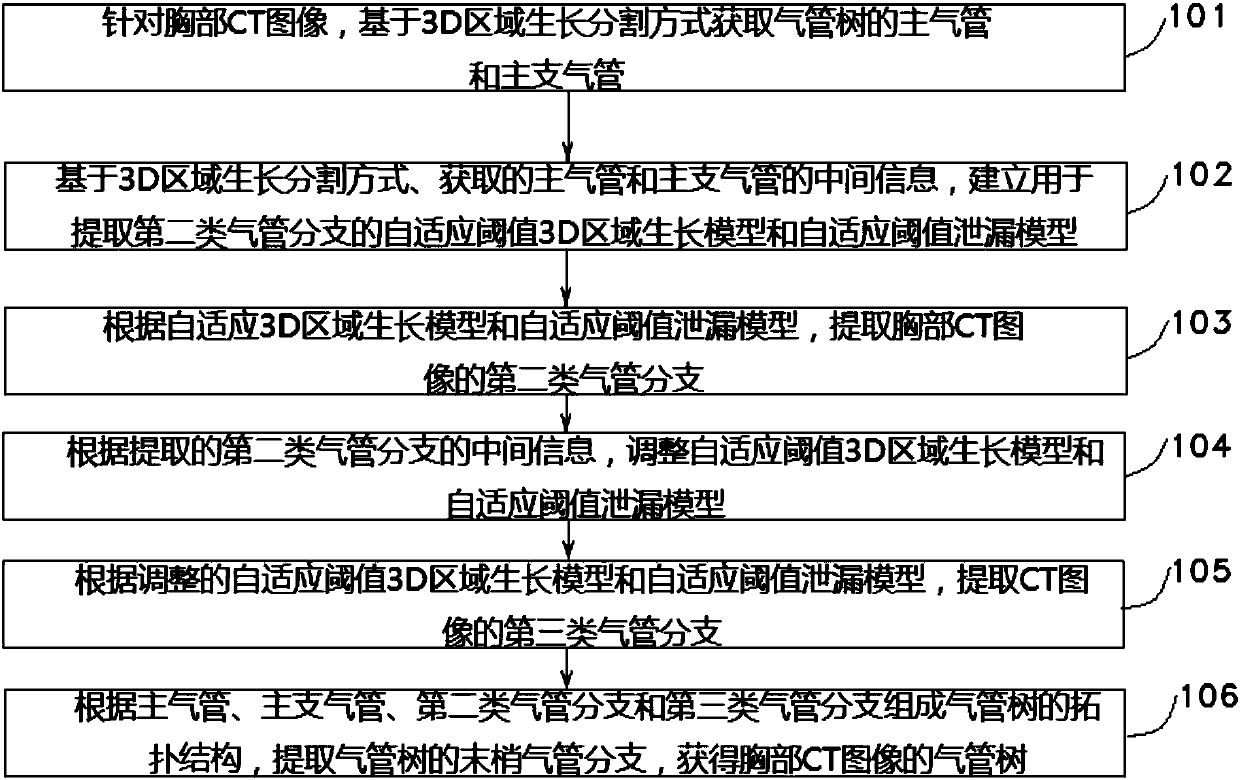Method for automatically extracting tracheal tree from chest CT image
A CT image and tracheal tree technology, applied in the field of image processing based on medical images, can solve problems such as difficulty in completing CT image segmentation tasks, restricting the accuracy of tracheal segmentation, and missing detailed information
- Summary
- Abstract
- Description
- Claims
- Application Information
AI Technical Summary
Problems solved by technology
Method used
Image
Examples
Embodiment 1
[0122] The technical problem solved by this embodiment is to provide a method for automatically extracting a tracheal tree from a chest CT image, using an adaptive threshold to avoid manual interaction and parameter setting required by the prior art, so as to adapt to various imaging conditions and pathological conditions tracheal tree segmentation task. like figure 1 As shown, the present invention provides a method for fully automatic extraction of trachea from chest CT images, and the technical solution is as follows:
[0123] 101. For the chest CT image, obtain the first type of tracheal branches of the tracheal tree based on the 3D region growth segmentation method, that is, the main trachea and the main bronchus, wherein the main bronchus includes the left main bronchus and the right main bronchus;
[0124] 102. Based on the 3D region growth segmentation method, the acquired intermediate information of the main trachea, and the acquired intermediate information of the m...
Embodiment 2
[0130] The main trachea and main bronchus are surrounded by a relatively complete and bright tracheal wall and separated from the lung parenchyma. The main trachea and main bronchus are extracted from the CT image without considering the leakage situation, which is less difficult. Therefore, the common threshold 3D region growth segmentation method is used. Effective access to the main trachea and main bronchi.
[0131] In this embodiment, the first type of tracheal branch is obtained from the chest CT image, including:
[0132] 1. Obtain the main trachea from chest CT images:
[0133] 1011. Read in the chest CT image, in order to avoid the influence of CT image noise on subsequent growth segmentation, perform a Gaussian smoothing preprocessing operation on the chest CT image with a three-dimensional scale of σ=0.5mm;
[0134] 1012. Obtain a layer of CT images of the preprocessed chest CT image from the chest top to the chest base, and perform image binarization processing on t...
Embodiment 3
[0152] In this embodiment, an adaptive threshold 3D region growth model and an adaptive threshold leakage model are established according to the acquired intermediate information such as trachea gray distribution, spatial scale, and segmentation process information of the main trachea and main bronchus.
[0153] The specific steps for establishing an adaptive threshold 3D region growth model are as follows:
[0154] 1021: Obtain an initial segmentation seed point set; the initial segmentation seed point set includes: all seed points in the segmentation queue of the left main bronchus when the iteration is terminated and all seed points in the segmentation queue of the right main bronchus when the iteration is terminated.
[0155] 1022: Obtain a grayscale threshold; in this embodiment, a certain grayscale threshold is set for the segmentation of the trachea tree to determine the upper limit of the trachea segmentation, and at the same time, the pixels whose grayscale values ex...
PUM
 Login to View More
Login to View More Abstract
Description
Claims
Application Information
 Login to View More
Login to View More - R&D
- Intellectual Property
- Life Sciences
- Materials
- Tech Scout
- Unparalleled Data Quality
- Higher Quality Content
- 60% Fewer Hallucinations
Browse by: Latest US Patents, China's latest patents, Technical Efficacy Thesaurus, Application Domain, Technology Topic, Popular Technical Reports.
© 2025 PatSnap. All rights reserved.Legal|Privacy policy|Modern Slavery Act Transparency Statement|Sitemap|About US| Contact US: help@patsnap.com



